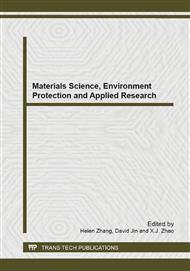[1]
Naoto Fujii, Yasushi Honda, Takeshi Ogawa & Bun Tsuji, etal. Short-term exercise-heat acclimation enhances skin vasodilation but not hyperthermic hyperpnea in humans exercising in a hot environment[J]. Eur J Physiol, 112, pp.295-307, (2012).
DOI: 10.1007/s00421-011-1980-6
Google Scholar
[2]
V.P. Golub. Experimental analysis of high-temperature creep, fitigue, and damage. 1. analysis methods. 37(4), pp.425-455, (2001).
Google Scholar
[3]
Li Rui-Fang, Sun Jian-Ya, Zhang Ping & Zheng Jin-Ping. Influecing factors of hypertension in steel workers exposed to heat stress [J]. China Public Health, 7(25), pp.818-820, (2009).
Google Scholar
[4]
Yuan Dang-Ming & Li Yong-Gang. Discussion of Vitamin B1, B2, C requirements among coal mine workers. Guangxi preventive medicine, 7(3), pp.139-131, (2001).
Google Scholar
[5]
Lin Chang-Qing, Guo Li Wen, Lai Jun-Qing & Huang Jin-Zhao. Vitamin B1, B2, C urine test among workers at high temperature[J]. Occupational medicine, 12(3), pp.6-7, (1985).
Google Scholar
[6]
M. Sniekers, V. Foulon, G.P. Mannaerts & L. Van Maldergem, etc. Thiamine pyrophosphate: An essential cofactor for the α-oxidation in mammals-implications for thiamine deficiencies[J]. Cell. Mol. Life Sci, 63, pp.1553-1563, (2006).
DOI: 10.1007/s00018-005-5603-4
Google Scholar
[7]
Gilles R. Dagenais, Roberto Marchioli, Gianni Tognoni & Salim Yusuf. Beta-Carotene, Vitamin C, and Vitamin E and Cardiovascular Diseases[J]. Current Science Inc, 2, pp.293-299, (2000).
DOI: 10.1007/s11886-000-0084-4
Google Scholar
[8]
Yu Shou-Yang & Liu Zhi-Cheng. The method of guide for nutrition and food hygiene supervision and inspection[M], Beijing: People's medical publishing house, pp.108-179, (1988).
Google Scholar
[9]
Qiu Ren-Zhi. Water-soluble vitamin metabolism during high temperature physical activity. [J]. The army health magazine, 5(3), pp.27-31, (1987).
Google Scholar
[10]
Li Yu-Jiu, Zu Guo-Dong, Yang Jun & Jia Hong-Li, etal, Study of vtamin B1, B2, C and minerals among workers at high temperature [J]. China Public Health, 14(8), pp.468-470, (1998).
Google Scholar


